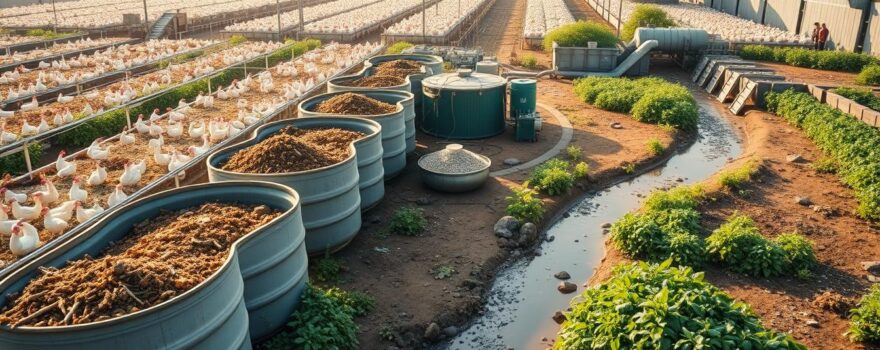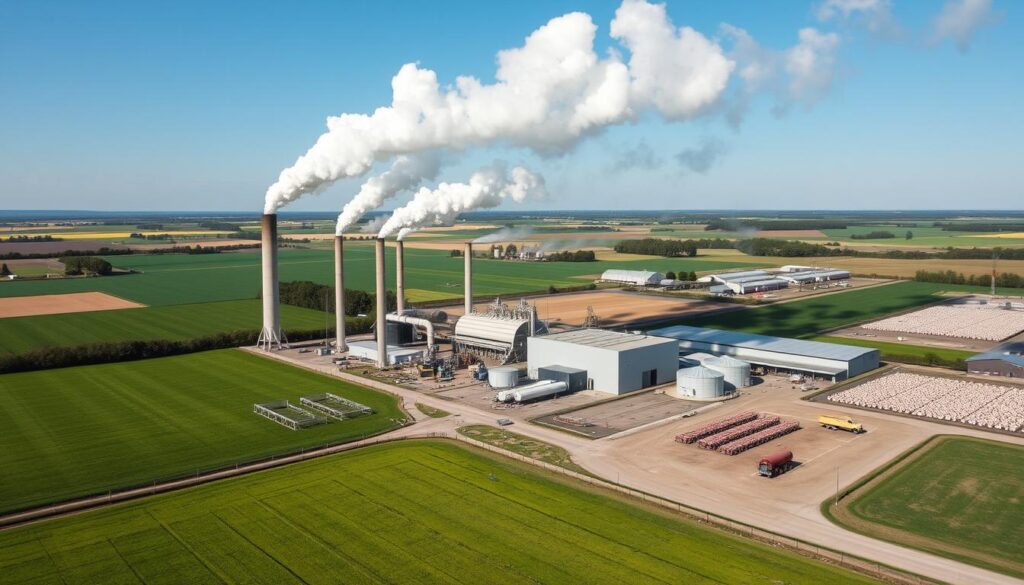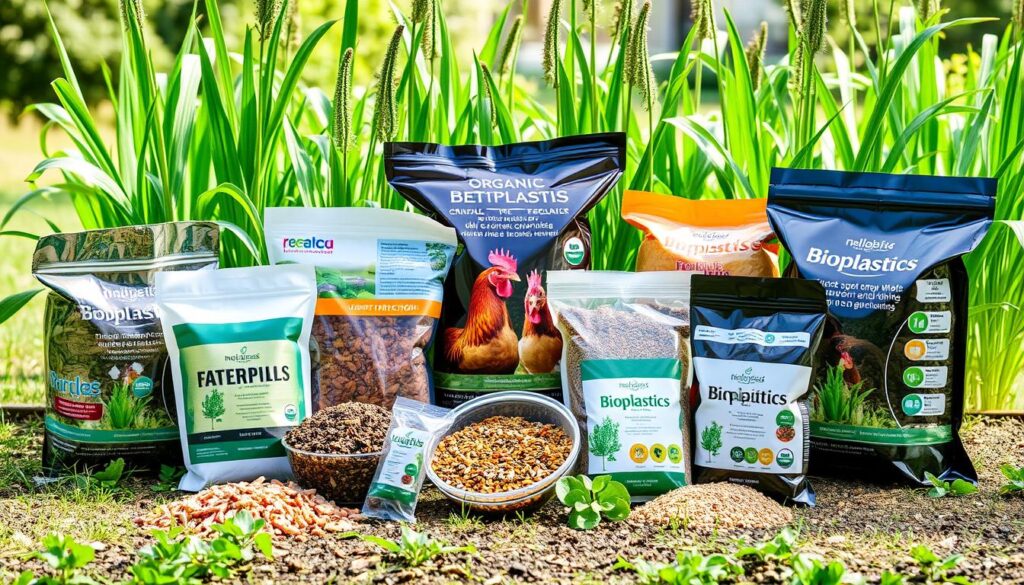
The poultry industry is key to feeding the world, but it faces a big challenge. It must manage a lot of waste, like chicken manure and litter. If not done right, this waste can harm the environment. Good poultry waste management is key to lessen the environmental impact of broiler farms and support sustainable broiler farming.
In the United States, the poultry industry is a big part of farming. It helps a lot with food and the economy. But, managing broiler litter disposal and nutrient management in broiler farms is getting more important. It’s vital to have good waste management strategies to tackle the environmental issues of broiler production.
Key Takeaways
- Effective poultry waste management is essential to minimize the environmental impact of broiler farms.
- Proper storage, containment, and disposal of poultry waste are crucial to prevent pollution and protect natural resources.
- Recycling poultry waste into valuable products, such as fertilizers and bioenergy, can enhance sustainability in the industry.
- Compliance with local and national regulations is vital for responsible waste management practices.
- Innovative technologies and sustainable farming practices can improve waste management and reduce the ecological footprint of broiler production.
Introduction to Poultry Waste and Its Environmental Concerns
Poultry farming is growing fast, but it creates a lot of waste. This waste includes poultry manure, litter, hatchery waste, and carcasses. It’s important to handle and dispose of this waste right to protect the environment.
Types of Poultry Waste
Poultry waste falls into several categories:
- Poultry manure: A mix of droppings, feathers, and spilled feed.
- Poultry litter: Bedding material mixed with chicken waste.
- Hatchery waste: Eggshells, infertile eggs, and dead embryos.
- Carcass waste: Dead chicken bodies.
Environmental Impacts of Unmanaged Poultry Waste
Unmanaged poultry waste can harm the environment in many ways:
- Water pollution: Nutrients, pathogens, and heavy metals can pollute water.
- Air quality degradation: Decomposing waste can release harmful gases and cause bad smells.
- Pathogen contamination: Waste can carry dangerous bacteria like E. coli and Salmonella.
- Soil degradation: Too much waste can upset soil nutrients.
Good waste management is key to reducing these problems. It helps keep the poultry industry sustainable.
Proper Storage and Containment of Poultry Waste
Managing poultry waste well is key to lessening the harm to the environment. Waste from broiler farms includes manure, litter, hatchery waste, and carcass waste. It’s important to store and contain this waste to avoid contamination.
Poultry litter, made of sawdust or straw mixed with excrement, needs to be stored safely. It should be in leak-proof pits or lagoons that can hold all waste until cleanouts. Covering these areas helps keep odors down and stops rain from polluting nearby waterways.
Poultry manure has a lot of nitrogen and phosphorus. If not managed, it can harm soil and water. Also, waste like litter can release harmful gases like ammonia and methane, affecting the air.
Farms should take steps to manage poultry waste storage and containment better. This includes building strong storage structures, keeping areas clean, and planning how to use litter as fertilizer.
By following these guidelines, broiler farms can reduce their environmental footprint. This helps make the poultry industry more sustainable.
Land Application and Nutrient Recycling
Using poultry litter as fertilizer on land is a smart way to reuse its nutrients. Poultry litter is full of nutrients like nitrogen, phosphorus, and potassium. It’s a cheaper and greener option than buying commercial fertilizers.
Using Poultry Litter as Fertilizer
Poultry litter has different nutrients based on the type of bird and how it’s managed. For instance, broiler litter has lots of nitrogen, phosphorus, and potassium. About 30-80% of the nitrogen in it is available to plants the year it’s applied.
Nutrient Management Planning for Sustainable Applications
For poultry litter to be used well as fertilizer, planning is key. This means testing the soil and plants, and adjusting how much litter is spread. The USDA-EPA says all animal feeding operations must have a plan by 2009.
Good planning helps farmers get the most out of poultry litter as fertilizer. It also prevents too much nutrient buildup in the soil or water pollution. By matching litter application to crop needs, farmers can use poultry waste sustainably and manage nutrients better.
“Producing the same amount of chicken today as in 1965 has resulted in a 50% decrease in environmental impact.”
Composting: Turning Poultry Waste into Valuable Soil Amendment
Composting turns poultry waste into a nutrient-rich soil amendment. It mixes waste with carbon-rich materials. This process creates a stable, high-quality compost.
The compost improves soil fertility and reduces chemical fertilizer use. It’s a cost-effective method for mortality disposal. This benefits the poultry industry and beyond.
The Science of Poultry Waste Composting
Effective poultry waste composting needs a balance of factors. The ideal carbon to nitrogen ratio is 5:1 to 25:1. Adding bulking agents like wood shavings helps maintain this balance.
Keeping the desired moisture levels between 40 to 60 percent is key. The compost pile should also have good air circulation. A typical bin is 6-8 feet wide, 5 feet high, and 5 feet deep.
The temperature profile is also important. Temperatures should rise to 130-150 degrees Fahrenheit. This kills pathogens and pests. But, temperatures over 170 degrees Fahrenheit can cause spontaneous combustion.
Turning Poultry Waste into Valuable Compost
The compost production process diverts waste from landfills and waterways. It turns waste into a valuable soil amendment. This compost improves soil fertility and reduces synthetic fertilizer use.
Composting addresses environmental concerns like nutrient runoff and greenhouse gas emissions. It turns waste into a sustainable resource. This enhances environmental stewardship and supports a circular economy.
| Composting Parameter | Ideal Range |
|---|---|
| Carbon to Nitrogen Ratio | 15:1 to 25:1 |
| Moisture Content | 40% to 60% |
| pH | 5 to 12 |
| Free Air Space | Greater than 30% |
Optimizing composting and using organic fertilizer from poultry waste helps the poultry industry. It supports a sustainable and regenerative agricultural system.
Anaerobic Digestion: Producing Biogas and Nutrient-Rich Digestate
Anaerobic digestion is a key method for managing poultry waste. It turns the waste into valuable resources. This process, without oxygen, breaks down the waste into biogas, mainly methane.
This biogas can be used as a clean energy source. It’s a green alternative to fossil fuels. The leftover solid, called digestate, is full of nutrients and can be used as fertilizer.
This reduces the need for chemical fertilizers. It makes farming more eco-friendly. Using anaerobic digestion of poultry waste and nutrient-rich digestate solves many waste management problems.
| Biogas Composition | Anaerobic Digester Requirements |
|---|---|
|
|
The anaerobic digestion process has three stages. These are acid formation, methane formation, and making nutrient-rich digestate. The digestate, 90-95% of the original, is great for plants and soil.
“Digestate is an excellent alternative to reduce chemical fertilizer application, improving plant-available nutrients and offsetting soil erosion.”
But, it’s important to manage and treat the digestate right. Methods like solid-liquid separation and drying make it ready for farms. By using anaerobic digestion of poultry waste, we can make our farms more sustainable.
Incineration: A Controlled Disposal Method for Poultry Waste
In the world of poultry waste management, incineration stands out as a reliable choice. It burns chicken waste at high temperatures, making it smaller and needing less storage. This method is great for farms worried about disease, keeping them safe.
Today’s incinerators are designed to protect the environment. They burn waste cleanly. The leftover ash is full of nutrients like phosphorus and potassium, perfect for fertilizers. Incineration is easy for small farms to use.
| Incineration Advantages | Incineration Disadvantages |
|---|---|
|
|
Incineration is a good way to handle poultry waste, but each farm is different. It’s important to think about what works best for your farm. By looking at the pros and cons, you can choose the best waste management plan.
“Incineration is a straightforward method for poultry mortality disposal and is particularly suitable for smaller operations.”

The Role of Waste Management in Reducing the Impact of Broiler Farms
Effective waste management is key for sustainable broiler farming. It turns waste into opportunities, helping farmers, communities, and the environment. Strategies like proper storage, nutrient recycling, composting, and anaerobic digestion reduce the impact of broiler farms and support sustainable broiler farming.
Studies show over 95% of poultry litter is recycled. Concrete pads at chicken house entrances make litter collection easier. Farmers can check gas levels, like ammonia, on their phones for better management. Grass or shrubs absorb water and limit erosion, and grass buffers capture air emissions, reducing environmental impact of broiler farms.
Sustainable waste management is vital for reducing waste, runoff, and emissions. A study in the Chesapeake Bay watershed found transport and processing of excess manure cost over $350 million annually. But, a transport subsidy program cut costs by 78% to 80%, showing cost-effective solutions are possible.
| Waste Management Strategy | Key Benefits |
|---|---|
| Nutrient Recycling | Converts poultry waste into valuable fertilizer, reducing the need for commercial alternatives |
| Composting | Turns poultry waste into nutrient-rich soil amendment, improving soil health |
| Anaerobic Digestion | Produces biogas for energy generation and nutrient-rich digestate for fertilizer |
By using these strategies, broiler farmers can lessen the environmental impact of broiler farms and support sustainable broiler farming. Yet, small and medium-sized farms face challenges like limited budgets and space. Overcoming these barriers is essential for widespread adoption of sustainable waste management in poultry farming.
Energy Generation from Poultry Waste
Poultry waste is a big chance for renewable energy. New ways to use waste are changing how farms deal with their waste. Anaerobic digestion, gasification, and incineration turn waste into useful energy like biogas, syngas, electricity, and heat.
Anaerobic Digestion: Biogas Production
Anaerobic digestion breaks down waste without oxygen. It makes biogas, a clean fuel for generators, heating, or even natural gas. This helps farms use less fossil fuel and helps the planet.
Gasification: Syngas and Electricity
Gasification turns waste into syngas, a mix of gases. This syngas powers generators, making clean electricity. It’s a smart way to get energy from waste, cutting down on fossil fuel use.
Incineration: Heat and Power
Incineration is good for energy generation from poultry waste if done right. It makes steam for electricity or heating. This way, waste is turned into power, not dumped in landfills.
Broiler farms can manage waste better with these waste-to-energy solutions. They help the environment and support sustainable energy. As farms use these technologies, they make a greener future possible.
Value-Added Products from Poultry Waste Processing
The poultry industry can make more than just energy and fertilizer from its waste. It can also create valuable products like litter ash and animal feed ingredients. This approach helps reduce environmental harm and opens up new ways to make money.
Fertilizers from Poultry Waste
Poultry litter is now turned into phosphorus-rich fertilizers. The ash from burning litter is especially valuable for phosphorus. This ash is used to make high-quality fertilizers that help crops grow and reduce waste.
Animal Feed Ingredients from Poultry Waste
Poultry waste, like mortalities and hatchery byproducts, is turned into animal feed. This feed is rich in protein and is used for livestock. It helps reduce the need for imported protein and keeps the industry’s resources in use.
Chemical Extracts from Poultry Waste
Poultry waste is also a source of chemicals and industrial products. Feathers, for example, can be used to make keratin. Keratin is used in cosmetics, pharmaceuticals, and textiles. Chitin and chitosan from eggshells and feathers have uses in water treatment, agriculture, and biomedicine.
By using poultry waste fully, the industry can lessen its environmental impact. It also creates new income sources and supports a sustainable, circular economy.

Developing an Optimal Waste Management Strategy
Creating a top-notch poultry waste management strategy is key to lessening the environmental harm from broiler farms. The right plan will vary based on several things. These include the farm’s size, local laws, land availability, and what to do with the waste. Usually, mixing strategies like storage, composting, anaerobic digestion, and incineration works best.
It’s smart to team up with pros when making a waste management plan. These experts guide farmers through rules, pick the best tech, and make sure waste is handled well and sustainably.
Important things to think about when making a poultry waste management plan are:
- The amount and type of waste made
- Space for storing and treating waste
- Chances for nutrient recycling and energy recovery
- Following local and regional environmental laws
- Ways to save money and make more
With help from waste management experts, farmers can make a detailed and optimal poultry waste management strategy. This strategy will help protect the environment and make the most of this valuable resource.
| Waste Management Strategies | Key Benefits |
|---|---|
| Storage and Containment | Prevents immediate release of nutrients and pathogens into the environment |
| Composting | Turns waste into nutrient-rich soil amendment |
| Anaerobic Digestion | Makes renewable biogas and nutrient-rich digestate |
| Incineration | Offers a controlled way to get rid of poultry waste |
By using a full poultry waste management strategy, broiler farms can lessen their environmental footprint. They also open up new chances for sustainable management and economic growth.
Managing poultry waste well is key to lessening the harm to our environment from broiler farms. By using smart storage, recycling nutrients, composting, anaerobic digestion, and controlled burning, farmers can make waste useful. This approach helps reduce risks and turns waste into something valuable.
Creating a waste management plan that fits the farm’s needs is essential. Getting help from experts in the field is also important. This way, farmers can be more eco-friendly and help make farming more sustainable. With more people wanting chicken and the need to protect the environment, the poultry industry must find new ways to manage waste.
This article shows how important it is to manage poultry waste well. It’s not just about protecting the environment. It’s also about using waste to make energy, fertilizers, and other useful products. By adopting these methods, the poultry industry can make a big difference in creating a greener future for farming.